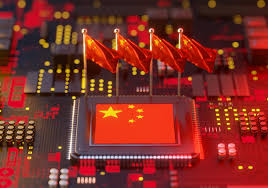China’s top tech firms, Tencent and Baidu, are actively finding ways to stay competitive in the global AI race, even as the United States imposes tighter controls on the export of high-performance semiconductors.
Both companies have taken strategic steps to address the shortage of advanced chips, which are crucial for training large AI models. These steps include stockpiling GPUs, using software optimization, designing smaller and more efficient AI models, and leveraging China-made chips to reduce dependence on foreign technology.
Tencent’s Strategy in the Global AI Race
Tencent, the company behind China’s popular messaging app WeChat, is tackling the chip shortage head-on. During a recent earnings call, President Martin Lau revealed that Tencent has built a “pretty strong stockpile” of graphics processing units (GPUs). These chips are vital for training AI systems because they handle complex computing tasks quickly and efficiently.
Interestingly, Lau mentioned that Tencent does not believe it needs massive GPU clusters like many American companies do. Instead, the company is using a smaller number of high-end chips more efficiently, allowing it to train powerful AI models without constantly buying new hardware.
He explained that Tencent is also working on software optimization to improve inference — the process where AI performs tasks after being trained. Lau emphasized the importance of focusing on smaller AI models that consume fewer resources and mentioned the possibility of using custom-designed chips made in China.
“We should have enough high-end chips to continue our training of models for a few more generations,” Lau said.
Baidu’s Full-Stack Approach to the AI Race
Baidu, China’s leading search engine, is also innovating to stay in the global AI game. The company is using what it calls a “full-stack” AI strategy, which includes cloud infrastructure, AI models, and applications such as its chatbot, ERNIE.
Dou Shen, President of Baidu’s AI Cloud, said that even without the most advanced chips, Baidu’s integrated approach allows it to build strong applications. The company has made significant progress in software optimization, which helps reduce the cost of running large AI models.
Shen added that owning the technology stack—from cloud servers to AI models—gives Baidu an edge in managing GPU resources effectively.
“The ability to build and manage large-scale GPU clusters and to use GPUs efficiently has become a key advantage,” Shen noted.
He also highlighted the advancement of domestic Chinese semiconductor companies, stating that self-sufficient chips and efficient home-grown software will support long-term innovation in China’s AI ecosystem.
The Growing Role of China-Made Semiconductors in the Global AI Race
Over the past few years, China has been developing its own semiconductor ecosystem, from raw materials and chip designs to fabrication and packaging. Although Chinese chips still lag behind the most advanced American GPUs, progress is evident.
Gaurav Gupta, a semiconductor analyst at Gartner, explained that stockpiling chips is just one method being used by Chinese firms to navigate export restrictions. He also noted that China’s consistency and ambition in developing its chip ecosystem have yielded notable success.
“These chips may not yet match the performance of U.S. leaders, but they continue to improve,” Gupta said.
US Chip Curbs May Backfire, Warns Nvidia CEO
Many in the U.S. tech industry, including Nvidia CEO Jensen Huang, have expressed concern over Washington’s chip export rules. Huang recently called the restrictions a “failure,” claiming that they are hurting American companies more than China.
Despite these restrictions, Tencent and Baidu are clearly finding innovative ways to maintain their positions in the global AI race, showing resilience and adaptability in a challenging geopolitical landscape.
If you are interested in reading more such International news, then stay tuned with 10X Times News.






